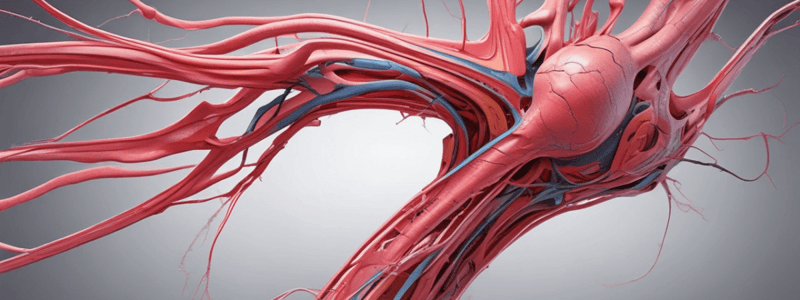Podcast
Questions and Answers
Which of the following is a characteristic feature of the tunica media in medium-sized muscular arteries?
Which of the following is a characteristic feature of the tunica media in medium-sized muscular arteries?
- It is a relatively thin layer with a prominent internal elastic lamina that is thrown into folds.
- It is composed of concentric layers of fenestrated elastic laminae separated by smooth muscle fibers.
- It is about 50% of the wall thickness and is composed of several concentric layers of smooth muscle fibers with little elastic and collagen fibers in between. (correct)
- It contains numerous vasa vasorum that provide nutrition to the adventitia and outer part of the media.
What is the function of the fenestrations in the elastic laminae of large arteries?
What is the function of the fenestrations in the elastic laminae of large arteries?
- To enable the formation of arteriovenous anastomoses.
- To allow the entry of additional blood during systole.
- To provide elasticity to the arterial wall.
- To facilitate the diffusion of nutrients through the arterial wall. (correct)
Which of the following statements about the tunica adventitia is correct?
Which of the following statements about the tunica adventitia is correct?
- It contains the external elastic lamina, which is particularly prominent in larger muscular arteries.
- It is about 20% of the wall thickness and merges into the surrounding connective tissue. (correct)
- It is composed of concentric layers of fenestrated elastic laminae separated by smooth muscle fibers.
- It is a relatively thin layer with a prominent internal elastic lamina that is thrown into folds.
What is the function of the vasa vasorum in the tunica adventitia?
What is the function of the vasa vasorum in the tunica adventitia?
Which of the following structures is responsible for the folding of the internal elastic lamina in medium-sized muscular arteries?
Which of the following structures is responsible for the folding of the internal elastic lamina in medium-sized muscular arteries?
Which of the following structures is not a component of the tunica intima in medium-sized muscular arteries?
Which of the following structures is not a component of the tunica intima in medium-sized muscular arteries?
What is the histological structure of capillaries?
What is the histological structure of capillaries?
What is a distinguishing characteristic of capillaries?
What is a distinguishing characteristic of capillaries?
Which structure partially surrounds the endothelial cells of capillaries and post-capillary venules?
Which structure partially surrounds the endothelial cells of capillaries and post-capillary venules?
What is the purpose of the basal lamina in relation to endothelial cells?
What is the purpose of the basal lamina in relation to endothelial cells?
Which vessels connect arteries and veins in peripheral circulation?
Which vessels connect arteries and veins in peripheral circulation?
What is the site of trans-migration of white blood cells during inflammation?
What is the site of trans-migration of white blood cells during inflammation?
Which of the following accurately describes the structure of continuous capillaries?
Which of the following accurately describes the structure of continuous capillaries?
Which of the following accurately describes the structure of fenestrated capillaries?
Which of the following accurately describes the structure of fenestrated capillaries?
Which type of capillary is found in muscular tissue, lung, skin, and nervous tissue?
Which type of capillary is found in muscular tissue, lung, skin, and nervous tissue?
Which of the following statements accurately describes the function of pericytes?
Which of the following statements accurately describes the function of pericytes?
Which type of capillary is characterized by the presence of fenestrations without a diaphragm, allowing for unrestricted exchange of molecules?
Which type of capillary is characterized by the presence of fenestrations without a diaphragm, allowing for unrestricted exchange of molecules?
Flashcards are hidden until you start studying



